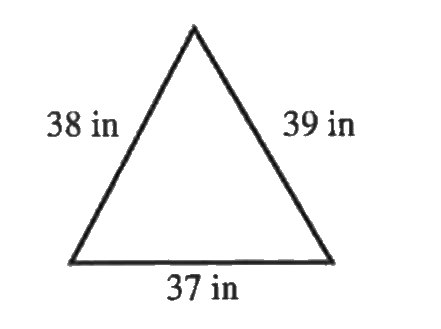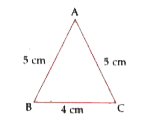Which of the following is the set of measure of the sides of a triangle?
8 cm, 4 cm, 20 cm
9 cm, 17 cm, 25 cm
11cm, 16 cm, 28 cm
None of these
The correct Answer is:B
To determine which set of measures can form a triangle, we will use the triangle inequality theorem. This theorem states that the sum of the lengths of any two sides of a triangle must be greater than the length of the third side.
Let's analyze each option step by step:
Step 1: Analyze Part A - 8 cm, 4 cm, and 20 cm
1. Check the first combination:
- Sum of 8 cm and 4 cm = 8 + 4 = 12 cm
- Compare with the third side (20 cm): 12 cm < 20 cm (not valid)
2. Check the second combination:
- Sum of 8 cm and 20 cm = 8 + 20 = 28 cm
- Compare with the third side (4 cm): 28 cm > 4 cm (valid)
3. Check the third combination:
- Sum of 4 cm and 20 cm = 4 + 20 = 24 cm
- Compare with the third side (8 cm): 24 cm > 8 cm (valid)
However, since one combination fails (12 cm < 20 cm), this set does not form a triangle.
Step 2: Analyze Part B - 9 cm, 17 cm, and 25 cm
1. Check the first combination:
- Sum of 9 cm and 17 cm = 9 + 17 = 26 cm
- Compare with the third side (25 cm): 26 cm > 25 cm (valid)
2. Check the second combination:
- Sum of 17 cm and 25 cm = 17 + 25 = 42 cm
- Compare with the third side (9 cm): 42 cm > 9 cm (valid)
3. Check the third combination:
- Sum of 9 cm and 25 cm = 9 + 25 = 34 cm
- Compare with the third side (17 cm): 34 cm > 17 cm (valid)
Since all combinations are valid, this set can form a triangle.
Step 3: Analyze Part C - 11 cm, 16 cm, and 28 cm
1. Check the first combination:
- Sum of 11 cm and 16 cm = 11 + 16 = 27 cm
- Compare with the third side (28 cm): 27 cm < 28 cm (not valid)
Since the first combination fails, this set does not form a triangle.
Step 4: Analyze Part D - None of these
Since we have found that only Part B can form a triangle, we do not need to analyze this option further.
Conclusion
The only set of measures that can form a triangle is from Part B: 9 cm, 17 cm, and 25 cm.
1. Check the first combination:
- Sum of 8 cm and 4 cm = 8 + 4 = 12 cm
- Compare with the third side (20 cm): 12 cm < 20 cm (not valid)
2. Check the second combination:
- Sum of 8 cm and 20 cm = 8 + 20 = 28 cm
- Compare with the third side (4 cm): 28 cm > 4 cm (valid)
- Sum of 4 cm and 20 cm = 4 + 20 = 24 cm
- Compare with the third side (8 cm): 24 cm > 8 cm (valid)
1. Check the first combination:
- Sum of 9 cm and 17 cm = 9 + 17 = 26 cm
- Compare with the third side (25 cm): 26 cm > 25 cm (valid)
- Sum of 17 cm and 25 cm = 17 + 25 = 42 cm
- Compare with the third side (9 cm): 42 cm > 9 cm (valid)
- Sum of 9 cm and 25 cm = 9 + 25 = 34 cm
- Compare with the third side (17 cm): 34 cm > 17 cm (valid)
1. Check the first combination:
- Sum of 11 cm and 16 cm = 11 + 16 = 27 cm
- Compare with the third side (28 cm): 27 cm < 28 cm (not valid)
Since we have found that only Part B can form a triangle, we do not need to analyze this option further.
The only set of measures that can form a triangle is from Part B: 9 cm, 17 cm, and 25 cm.
Topper's Solved these Questions
Similar Questions
Knowledge Check
In triangle ABC, AB = 5 and AC = 3. which one of the following is the measure of the length of side BC?
ABC<7BBC=7CBC>7DIt cannot be determined from the information givenThe triangle shown below has side lengths 37, 38 and 39 inches. Which of the following expression gives the measure of the largest angle of the triangle?
(Note : For every triangle with sides of length a, b and c that are opposite ∠A,∠B,and∠C, respectively. c2=a2+b2−2abcosC.)
 Acos−1(−372−382−3922(38)(39))Bcos−1(−392−372−3822(37)(38))Ccos−1(372−382−392+2(38)(39))Dcos−1(382−372−392+2(37)(39))
Acos−1(−372−382−3922(38)(39))Bcos−1(−392−372−3822(37)(38))Ccos−1(372−382−392+2(38)(39))Dcos−1(382−372−392+2(37)(39))The following are the measures of the sides of five different triangles. Which of them represents a right triangle?
A√3,√4,√5B1,5,4C3,4,5D√3,√7,√4
Write of the following statements as true or false? The set of all equilateral triangles is a subset of the set of all isosceles triangles.
View SolutionWhat universal set(s) would you propose for each of the following :(i) The set of right triangles. (ii) The set of isosceles triangles.
View SolutionWhat universal set(s) would you propose for each of the following ?
(i) The set of right triangles
(ii) The set of isosceles triangles.
View SolutionThe side lengths of a certain triangle are 4, 5, and 7 centrimeters. Which of the following descriptions best classifies this triangle?
View SolutionName the following triangle with regards to sides :

View Solution
